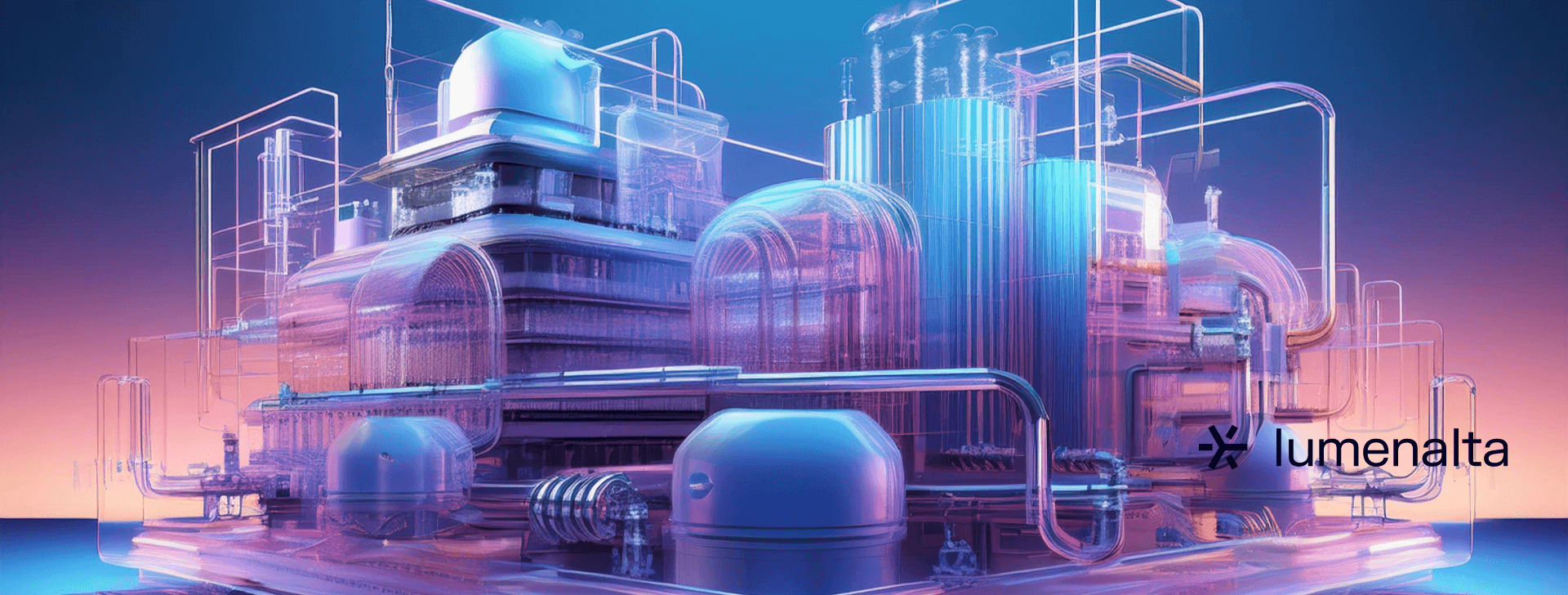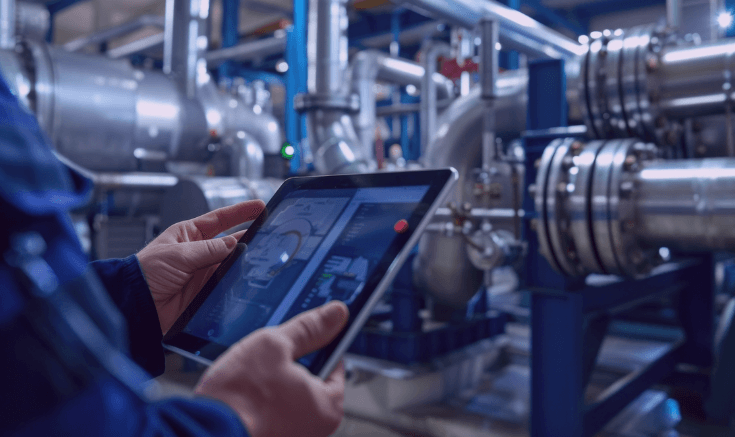

How AI models are enhancing HVAC design and performance
NOV. 13, 2024
7 Min Read
AI is transforming HVAC (heating, ventilation, and air conditioning) design by enabling systems to work smarter, respond faster, and deliver greater efficiency than ever before.
Its ability to adapt dynamically to user needs, environmental changes, and energy demands sets a new standard for innovation and sustainability in building systems.
One significant advantage of AI in HVAC design lies in its ability to leverage real-time data for performance optimization. For example, machine learning models analyze vast amounts of sensor data to predict heating or cooling needs. This capability enables systems to adjust proactively, ensuring consistent indoor climate control without manual intervention. Furthermore, the integration of AI in HVAC systems facilitates predictive maintenance, helping to identify potential issues before they become costly repairs.
Moreover, AI-powered HVAC design addresses sustainability challenges by promoting energy efficiency. Systems equipped with AI can optimize power usage based on occupancy patterns, weather forecasts, and real-time energy costs. This adaptability not only reduces operational expenses but also supports eco-friendly initiatives by lowering the carbon footprint of buildings.
Key takeaways
- 1. AI optimizes HVAC energy efficiency by analyzing real-time data and adjusting operations dynamically to minimize waste.
- 2. Predictive maintenance powered by AI identifies and resolves system issues before failures occur, reducing downtime and costs.
- 3. AI supports sustainability by integrating renewable energy sources and enabling compliance with environmental standards.
- 4. Scalable and adaptive AI solutions ensure HVAC systems remain future-proof as operational demands evolve.
- 5. AI for HVAC systems enhance occupant comfort through personalized climate control and advanced air quality management.
Benefits of AI in HVAC systems

AI-driven HVAC systems are setting a new benchmark in building management by combining advanced technologies with intelligent algorithms to deliver unmatched efficiency, reliability, and sustainability. As buildings become more complex, the demand for smarter climate control solutions grows. Traditional systems, while functional, often struggle to balance energy consumption, maintenance costs, and user comfort. AI offers a transformative approach, addressing these challenges with precision and adaptability. By leveraging real-time data, predictive capabilities, and machine learning, AI empowers HVAC systems to deliver consistent performance tailored to the needs of both the environment and occupants.
These systems are more than just innovative; they are essential tools for businesses looking to reduce operational costs and align with environmental standards. Whether it’s optimizing energy use, improving air quality, or predicting maintenance needs, AI ensures HVAC solutions remain ahead of the curve. Below are six critical benefits that highlight why AI-driven HVAC systems are rapidly becoming the cornerstone of modern building design.
- Enhanced energy efficiency: AI optimizes energy consumption by analyzing real-time data from sensors and adjusting system outputs accordingly. For example, it can lower heating or cooling levels during periods of low occupancy, resulting in significant cost savings and a reduced environmental footprint.
- Predictive maintenance: Traditional HVAC systems often fail unexpectedly, leading to costly downtime and repairs. AI-driven systems continuously monitor performance, identifying anomalies and predicting potential failures before they occur. This proactive approach minimizes disruptions and extends equipment lifespan.
- Improved indoor air quality: AI helps maintain superior air quality by dynamically controlling ventilation rates and filtration systems. It ensures pollutants are minimized and fresh air circulation is maximized, providing healthier environments for occupants.
- Adaptive climate control: These systems learn and adapt to user preferences and environmental conditions over time. By fine-tuning operations based on past patterns and current requirements, AI ensures optimal comfort without wasting energy.
- Scalable solutions: AI-driven systems are highly adaptable, making them suitable for both small-scale residential applications and large commercial or industrial complexes. This flexibility supports growth and changing needs without requiring significant system overhauls.
- Sustainability integration: Beyond immediate operational benefits, AI systems align with broader environmental goals by reducing greenhouse gas emissions and incorporating renewable energy sources effectively. For instance, AI can balance energy consumption with the availability of solar or wind power.
The future of HVAC lies in systems that can think, adapt, and evolve. AI-driven HVAC systems exemplify this vision by transforming static technology into dynamic, responsive, and highly efficient tools. These systems don’t just solve problems—they prevent them, anticipate needs, and contribute to a greener, more sustainable future. Whether you’re managing a single property or a portfolio of buildings, the shift to AI-driven HVAC is a step toward operational excellence and environmental stewardship.
AI models for HVAC performance optimization
AI models play a central role in optimizing HVAC performance, enabling systems to deliver efficient and tailored climate control. By analyzing vast amounts of data and applying advanced algorithms, these models transform how HVAC systems predict, adapt, and operate. Below are key ways AI models contribute to this optimization:
Predictive analytics for energy management
Predictive models use historical and real-time data to forecast energy demands, adjusting HVAC operations proactively. By factoring in variables such as weather patterns, occupancy trends, and energy costs, these models ensure that the system runs at peak efficiency while minimizing waste.
Adaptive control mechanisms
AI-driven HVAC systems incorporate adaptive control models that continuously learn and refine operations. These models adjust system settings dynamically, responding to changing environmental conditions or user preferences. For instance, they can modify airflow or temperature settings in real time to maintain optimal comfort and energy balance.
Fault detection and diagnostics
Machine learning algorithms within AI models can identify performance anomalies, often predicting faults before they impact operations. These diagnostic tools ensure that issues are addressed swiftly, reducing downtime and maintenance costs while maintaining system reliability.
Demand-response optimization
AI models facilitate effective demand-response strategies, particularly in large commercial settings. By syncing HVAC performance with utility grid demands, these models help lower peak energy usage, often leveraging incentives or lower rates during off-peak hours. This capability benefits both operational budgets and broader energy grids.
AI models for HVAC optimization are redefining operational possibilities by making systems more intelligent, responsive, and resilient. They do more than just refine performance—they elevate it to a new standard, where systems adapt in real time to changing needs and deliver sustainable outcomes. This dynamic interplay between predictive insights, adaptive controls, and robust diagnostics ensures that HVAC systems stay ahead of the curve, ready to meet the challenges of modern buildings. Whether you’re managing energy costs, enhancing user comfort, or aligning with sustainability goals, AI models provide the toolkit to achieve results that were once out of reach.
As the role of AI in HVAC design continues to expand, these models will become the cornerstone of smarter, greener infrastructure. They unlock a future where HVAC systems aren’t just functional but transformative, playing a critical role in reducing energy consumption, minimizing downtime, and fostering innovation in building management.
Integrating AI with existing HVAC infrastructure
Integrating AI with existing HVAC systems offers a practical pathway to modernizing operations without requiring a complete overhaul. By leveraging data from current equipment and combining it with AI capabilities, businesses can improve system efficiency, reduce energy consumption, and enhance user comfort—all while extending the lifespan of existing assets.
For many organizations, the integration process begins with retrofitting existing HVAC systems with sensors and IoT (Internet of Things) devices. These components collect real-time data, such as temperature, humidity, and energy usage, which serves as the foundation for AI-driven decision-making. The addition of AI-powered controllers allows systems to analyze this data and adjust settings dynamically to meet varying demands.
Beyond hardware upgrades, integrating AI involves adopting software platforms that enable advanced analytics and predictive capabilities. These platforms often work seamlessly with existing building management systems (BMS), creating a unified ecosystem that maximizes operational efficiency. For example, AI can synchronize HVAC performance with lighting systems or occupancy schedules, ensuring that energy use aligns with actual needs.
This approach also supports phased implementation, allowing organizations to gradually incorporate AI into their HVAC infrastructure. Whether starting with a single facility or rolling out updates across multiple locations, this incremental strategy minimizes disruption and ensures that each step adds measurable value.
Integrating AI into existing HVAC systems bridges the gap between traditional equipment and modern smart technologies. This process not only enhances performance but also ensures that organizations can achieve their efficiency and sustainability goals without the cost or downtime of full system replacement.
AI-powered predictive maintenance and troubleshooting

AI-powered predictive maintenance and troubleshooting are reshaping how HVAC systems are monitored and managed. By leveraging machine learning algorithms and real-time analytics, these technologies allow businesses to proactively address issues before they escalate into costly failures or downtime.
Predictive maintenance works by continuously analyzing data from sensors embedded in HVAC equipment. This data—such as vibration levels, airflow rates, and energy consumption—is fed into AI models that detect anomalies and predict when components are likely to fail. For example, an AI-driven system can identify subtle changes in compressor performance, signaling the need for maintenance well before a breakdown occurs.
Troubleshooting is another area where AI excels. By integrating diagnostic algorithms, these systems can pinpoint the root cause of performance issues in seconds, providing actionable insights to technicians. This speeds up repair times, reduces labor costs, and minimizes system downtime.
Key benefits of AI-powered predictive maintenance and troubleshooting:
- Proactive problem-solving: AI helps organizations shift from reactive to proactive maintenance strategies, reducing the likelihood of unplanned outages.
- Lower maintenance costs: By addressing issues early, businesses can avoid expensive repairs and replacements while extending equipment life.
- Improved reliability: Predictive capabilities ensure HVAC systems run smoothly, providing consistent comfort and air quality for occupants.
- Minimized downtime: Quick troubleshooting and early interventions reduce the time HVAC systems are offline, ensuring business continuity.
- Enhanced technician efficiency: AI provides technicians with precise insights, enabling them to focus on targeted solutions rather than broad diagnostics.
- Data-driven decisions: Continuous monitoring and reporting allow organizations to make informed decisions about system upgrades and energy management.
AI-powered predictive maintenance and troubleshooting do more than just prevent system failures—they represent a new standard for operational excellence. By providing foresight and precision, these technologies empower businesses to operate HVAC systems with greater confidence, efficiency, and reliability. For facility managers, this means fewer unexpected disruptions and a more streamlined approach to maintenance.
At the strategic level, AI also drives better long-term planning by offering actionable insights into equipment performance trends, enabling organizations to align maintenance schedules with broader operational goals. As a result, businesses can not only reduce costs but also elevate their environmental stewardship, creating HVAC systems that are as sustainable as they are reliable. The integration of predictive capabilities ensures HVAC systems evolve into proactive assets that contribute to both financial success and occupant satisfaction.
Energy efficiency and sustainability through AI

Energy efficiency and sustainability are at the forefront of modern HVAC design, and AI is proving to be a pivotal force in achieving these goals. By optimizing system performance and minimizing energy consumption, AI-driven HVAC systems contribute to reducing operational costs and supporting environmental initiatives.
AI enhances energy efficiency by utilizing real-time data to adjust HVAC settings dynamically. For instance, machine learning algorithms analyze patterns in occupancy, outdoor weather, and energy prices to determine the optimal heating or cooling output at any given time. This ensures that HVAC systems deliver the required comfort levels while avoiding energy waste. Over time, these adjustments can result in significant reductions in utility bills and carbon emissions.
Sustainability is further reinforced through AI's ability to integrate renewable energy sources into HVAC operations. Systems can synchronize energy demands with the availability of solar or wind power, maximizing the use of clean energy while maintaining operational reliability. Additionally, AI-powered analytics provide insights into energy usage trends, enabling businesses to set measurable sustainability goals and track their progress.
AI also supports green building certifications by ensuring that HVAC systems comply with energy efficiency standards and environmental benchmarks. This not only enhances a building’s marketability but also positions businesses as leaders in sustainable practices. As a result, AI-driven HVAC systems serve as critical tools in bridging the gap between operational excellence and environmental responsibility.
Challenges in implementing AI for HVAC
The adoption of AI in HVAC design and operation holds immense promise, but realizing its full potential requires overcoming several critical challenges. From infrastructure readiness to data reliability, these hurdles can pose significant barriers, particularly for organizations that rely on older systems or lack the necessary technical expertise. Despite the transformative impact AI offers, its implementation often demands a careful balancing act between costs, operational demands, and long-term goals. Addressing these challenges head-on is essential to unlock the value AI can bring to HVAC systems, including greater energy efficiency, improved sustainability, and proactive maintenance.
As AI-driven solutions become more accessible, organizations must be prepared to navigate the complexities of integration and adaptation. Below are some of the most pressing challenges businesses face when implementing AI in HVAC systems, as well as strategies to mitigate these issues and ensure successful outcomes.
Infrastructure compatibility
Integrating AI into traditional HVAC systems can be challenging due to differences in technology generations. Many older systems lack the necessary sensors and IoT capabilities to provide real-time data. Retrofitting these systems requires significant investment in hardware upgrades and may involve temporary disruptions to operations.
Data availability and quality
AI relies on large volumes of accurate data to deliver meaningful insights. Incomplete, inconsistent, or poor-quality data can compromise the effectiveness of AI models. Establishing reliable data streams from HVAC systems is often a complex task, requiring coordination between multiple stakeholders.
Technical expertise
Implementing AI-driven solutions requires specialized skills in data science, machine learning, and system integration. Many organizations lack in-house expertise, necessitating collaboration with external vendors or the recruitment of highly skilled professionals, which can increase costs and elongate timelines.
Security and privacy concerns
As AI systems rely on data collection and connectivity, they are susceptible to cyber threats. Protecting sensitive data, including occupancy patterns and energy usage, requires robust cybersecurity measures. Organizations must also comply with regulatory requirements regarding data privacy.
Cost barriers
The upfront cost of deploying AI-driven HVAC systems can be prohibitive for some businesses. While long-term savings are a key advantage, the initial investment in hardware, software, and expertise may deter smaller organizations or those with limited budgets.
Despite these challenges, the path to integrating AI in HVAC systems is far from insurmountable. By taking a strategic approach that includes phased implementation, strong cybersecurity measures, and collaborations with experienced vendors, businesses can overcome these hurdles effectively. Organizations that address these challenges early not only position themselves to reap the rewards of AI-driven HVAC systems but also gain a competitive edge in energy management and sustainability efforts.
As the industry evolves, tackling these obstacles will pave the way for smarter, greener, and more resilient HVAC systems. With the right investments and a commitment to innovation, the integration of AI in HVAC design can transform challenges into opportunities, delivering long-term value and operational excellence.
Best practices for adopting AI in HVAC design
Successfully integrating AI into HVAC design requires a strategic and well-planned approach to maximize its potential while minimizing implementation challenges. Businesses can benefit greatly from AI’s capabilities when they adopt practices that align technological innovation with operational goals. These best practices are essential for ensuring a smooth transition and long-term success in leveraging AI for HVAC systems.
Conduct a thorough needs assessment
Before adopting AI-driven HVAC solutions, it’s critical to identify specific pain points and goals. Assess your current HVAC system’s performance, energy efficiency, and maintenance requirements. This process helps pinpoint areas where AI can deliver the most value, such as predictive maintenance or dynamic energy management.
Invest in data quality and management
AI relies heavily on accurate and reliable data. Ensure your HVAC systems are equipped with high-quality sensors to collect real-time data on temperature, humidity, energy use, and other parameters. Additionally, establish robust data management protocols to process and store this information securely and effectively.
Choose scalable solutions
When selecting AI systems, opt for solutions that can scale with your operations. Whether you manage a single facility or a portfolio of properties, scalability ensures your investment remains valuable as your business grows. Scalable AI platforms can adapt to changing requirements and integrate seamlessly with additional systems or devices.
Collaborate with experienced vendors
Partnering with experts in AI and HVAC integration can significantly streamline the adoption process. These vendors bring specialized knowledge in system design, data analytics, and predictive modeling, ensuring your AI implementation aligns with industry standards and best practices.
Train your team
Providing adequate training for your staff is essential to ensure they understand and can effectively operate AI-driven systems. This includes educating technicians on how to interpret AI-generated insights, respond to system recommendations, and troubleshoot issues as they arise.
Monitor and iterate
AI systems thrive on continuous improvement. Regularly monitor the performance of your AI-driven HVAC systems, analyze key metrics, and identify opportunities for optimization. This iterative approach helps refine system operations and ensures you’re leveraging AI to its fullest potential.
Adopting AI in HVAC design is more than just a technological upgrade—it’s a transformative journey toward creating smarter, more sustainable systems. However, success depends on implementing these systems with a clear understanding of their capabilities and limitations. Businesses must recognize that AI integration is not a one-size-fits-all solution; it requires customization, collaboration, and a commitment to continuous improvement.
By building strong foundations—such as ensuring data accuracy, prioritizing scalability, and fostering expertise within your team—you can unlock the full potential of AI to revolutionize your HVAC operations. These practices don’t just make adoption easier; they ensure your systems remain agile and future-proof, capable of evolving alongside technological advancements and operational needs.
Organizations that prioritize these best practices position themselves to lead in efficiency, sustainability, and innovation. The integration of AI into HVAC design offers a compelling opportunity to not only improve system performance but also align with broader strategic goals, such as reducing costs, enhancing user comfort, and supporting environmental responsibility. With the right approach, AI becomes a powerful ally in creating HVAC systems that meet the demands of today and anticipate the challenges of tomorrow.
"AI systems thrive on continuous improvement, regularly analyzing key metrics and identifying opportunities for optimization."
5 use cases of successful AI applications in HVAC

AI is proving to be a game-changer for HVAC systems, offering innovative solutions to address critical challenges across industries. From commercial buildings and industrial facilities to healthcare environments and residential spaces, AI-driven systems are delivering measurable improvements in energy efficiency, operational reliability, and occupant comfort. Each use case highlights how AI can transform HVAC operations, blending predictive analytics, real-time data processing, and advanced control mechanisms to achieve results that traditional systems cannot match. These examples demonstrate the adaptability and scalability of AI, making it an indispensable tool in modern building management and sustainability efforts.
By addressing specific needs—whether maintaining precise temperature controls in healthcare or reducing carbon emissions in retail—AI-driven HVAC systems showcase their ability to align operational goals with broader environmental and economic objectives. Below are five powerful examples of how AI is being successfully implemented to drive change in HVAC systems across diverse settings.
1. Energy management in commercial buildings
AI is optimizing energy use in large-scale commercial properties by analyzing real-time occupancy and weather data. For example, advanced AI models predict peak energy demand and adjust heating or cooling accordingly, ensuring efficient energy distribution. In one case, an AI-powered HVAC system in a 50-story office building reduced energy costs by 30% within a year.
- AI integrates with energy grids to utilize lower-cost power during off-peak hours.
- Systems dynamically balance heating and cooling to meet real-time demand.
- Predictive analytics help businesses plan energy budgets more accurately.
This application underscores AI's ability to align energy usage with sustainability goals, reducing costs while lowering environmental impact.
2. Improved comfort in healthcare facilities
Maintaining precise temperature and air quality is critical in healthcare settings. AI-driven HVAC systems adapt to varying needs in real time, such as controlling humidity in surgical suites or managing airflow in patient wards. One hospital reported a 40% increase in HVAC reliability after implementing AI-based controls.
- Sensors continuously monitor and adjust air pressure and temperature.
- AI minimizes airborne contaminants through intelligent filtration.
- Predictive maintenance reduces disruptions in critical operations.
This use case highlights AI's role in enhancing patient safety and comfort while ensuring compliance with strict healthcare standards.
3. Predictive maintenance in industrial facilities
In manufacturing plants, HVAC systems are essential for maintaining optimal working conditions and equipment performance. AI-powered predictive maintenance has reduced unexpected failures by 50% in one large-scale factory.
- Machine learning models identify wear and tear before it escalates.
- AI minimizes downtime through timely maintenance alerts.
- Systems prioritize repairs based on potential impact on operations.
This example demonstrates how AI improves reliability, prolongs equipment life, and ensures seamless operations in demanding environments.
4. Smart homes with personalized climate control
AI is enhancing residential HVAC systems by learning user behaviors and preferences. Smart thermostats equipped with AI algorithms create customized climate profiles, delivering comfort while saving energy. One family saved 20% on annual energy costs by adopting temperature controls with AI.
- Systems learn schedules to adjust heating and cooling automatically.
- AI integrates with smart devices for seamless user control.
- Real-time data ensures optimal performance and energy use.
This application emphasizes AI’s ability to enhance convenience and energy efficiency in everyday life.
5. Sustainability in retail environments
Retail chains are using AI in HVAC systems to meet sustainability goals while maintaining customer comfort. One chain achieved a 25% reduction in energy consumption across 100 stores by integrating AI into their HVAC management.
- AI analyzes foot traffic patterns to optimize HVAC operation.
- Energy use aligns with business hours and ambient conditions.
- Systems track and report carbon emissions to meet regulatory standards.
This use case highlights AI's capability to balance environmental responsibility with operational efficiency.
AI is no longer just a tool for optimization—it’s a driver of transformation across industries. These five use cases illustrate how AI adapts to diverse challenges, offering tailored solutions that bridge operational needs with strategic objectives. Whether it’s achieving energy savings in commercial buildings, enhancing air quality in healthcare, or creating smarter homes, AI HVAC systems deliver tangible value while advancing sustainability.
As more industries adopt AI in their HVAC operations, the future of building management looks efficient, adaptive, and environmentally conscious. These real-world applications serve as a roadmap for businesses looking to harness the full potential of AI, proving that with the right approach, HVAC systems can evolve into powerful allies in achieving energy efficiency and sustainability goals.
"AI-powered HVAC systems adapt to varying needs in real time, such as controlling humidity in surgical suites or managing airflow in patient wards."
Emerging innovations in AI-enhanced HVAC design
The future of HVAC design is poised to be revolutionized by advancements in artificial intelligence, reshaping how buildings are managed and environments are controlled. Emerging trends highlight a shift toward systems that are not only smarter and more efficient but also more integrated and sustainable. These developments promise to address rising demands for energy optimization, environmental responsibility, and personalized climate control.
"The next decade will see HVAC systems transform into proactive, intelligent solutions that not only enhance building efficiency but also contribute significantly to global sustainability efforts."
One significant trend is the integration of AI with digital twin technology. Digital twins are virtual replicas of physical HVAC systems that use real-time data to simulate performance, predict issues, and test scenarios without affecting actual operations. This technology enables precise system optimization and allows stakeholders to make data-driven decisions about energy use, maintenance, and upgrades.
Another key trend is the use of AI in decentralized HVAC systems. These systems break away from centralized models by employing localized climate control units powered by AI algorithms. Decentralized systems offer increased flexibility, efficiency, and scalability, especially in large facilities or mixed-use spaces.
Sustainability will remain a central focus, with AI driving innovations in renewable energy integration. Future HVAC systems will seamlessly incorporate solar, wind, and other green energy sources, optimizing their usage in real time to minimize carbon footprints. Additionally, AI’s role in monitoring and reporting on energy usage will help businesses meet stringent environmental regulations.
Advancements in occupant-centered control are also on the horizon. AI-driven HVAC systems will leverage wearable technology, IoT devices, and advanced sensors to create hyper-personalized environments. These systems will adapt to individual preferences and health needs, offering unprecedented levels of comfort and well-being.
Looking ahead, the convergence of AI with other cutting-edge technologies, such as 5G and edge computing, will further enhance HVAC capabilities. Faster data processing and reduced latency will enable systems to react instantly to changes in occupancy or environmental conditions, ensuring optimal performance at all times.
As AI continues to evolve, it will redefine the boundaries of what HVAC systems can achieve. The next decade will see HVAC systems transform into proactive, intelligent solutions that not only enhance building efficiency but also contribute significantly to global sustainability efforts. Businesses that embrace these innovations early will position themselves as leaders in a rapidly advancing field, ready to meet the challenges of tomorrow with confidence.
AI in HVAC design isn’t just a technological innovation—it’s a smarter way to optimize comfort, energy efficiency, and sustainability. By leveraging predictive capabilities, real-time data, and intelligent controls, AI empowers businesses to meet the challenges of modern building management with confidence. At Lumenalta, we specialize in crafting AI-driven solutions tailored to your unique needs, ensuring your HVAC systems operate at their full potential. Explore how our expertise in AI-powered technology can transform your HVAC operations and drive meaningful results. Let’s build smarter systems together.
Table of contents
- Benefits of AI in HVAC systems
- AI models for HVAC performance optimization
- Integrating AI with existing HVAC infrastructure
- AI-powered predictive maintenance and troubleshooting
- Energy efficiency and sustainability through AI
- Challenges in implementing AI for HVAC
- Best practices for adopting AI in HVAC design
- 5 Use Cases of Successful AI applications in HVAC
- Emerging innovations in AI-enhanced HVAC design
- Common questions about ai for hvac design
Common questions about AI for HVAC design
What are the main benefits of AI for HVAC design?
How does AI improve HVAC energy management?
Can AI be integrated into older HVAC systems?
What role does AI play in HVAC sustainability efforts?
How does AI for HVAC systems ensure reliable maintenance?
Want to learn how AI for HVAC can bring more transparency and trust to your operations?












